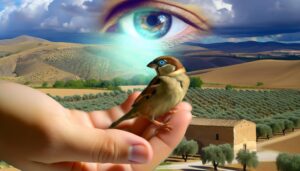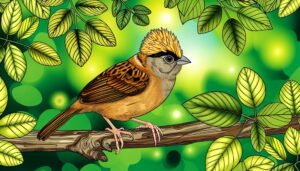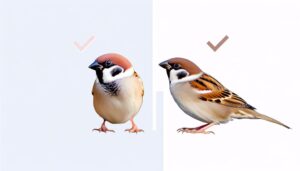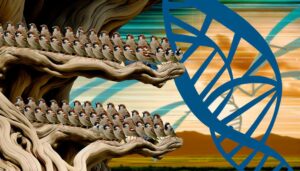10 Common Sparrows to Spot in Texas
Texas is home to diverse Sparrow species, each with intriguing characteristics. The House Sparrow, known for its adaptability and resilience, is a prevalent urban dweller.
The Song Sparrow, recognized by its streaked underparts and tail twitching during takeoff. The Lark Sparrow boasts a chestnut-and-white head pattern, while the Chipping Sparrow is known for its bright rust-colored cap.
The Savannah Sparrow features a unique yellow eyebrow stripe, and the grasshopper-like song of the Grasshopper Sparrow sets it apart. There's a fascinating world to explore when digging deeper into the behavioral patterns, habitats, and conservation efforts focusing on these feathered natives.
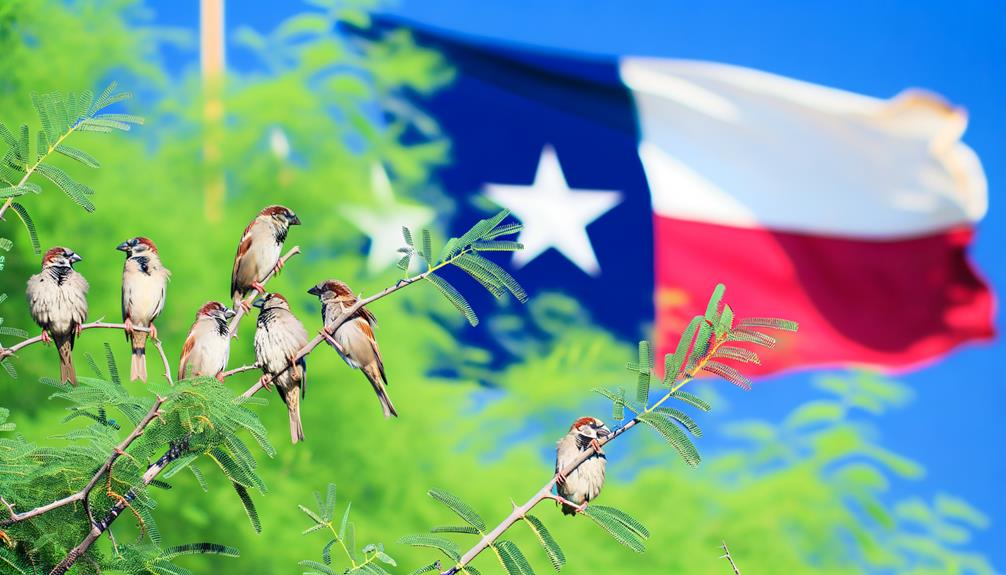
Key Takeaways
- Texas is home to various sparrow species, including House Sparrow, Lark Sparrow, Song Sparrow, and Chipping Sparrow.
- The House Sparrow is highly adaptable, often found in human establishments, and is distinguishable by its black bib and brown streaked upper parts.
- The Lark Sparrow, identified by its chestnut-and-white head pattern, and the Song Sparrow, known for its streaked underparts and tail-twitching behavior, are also common.
- The Chipping Sparrow with its bright rust-colored cap is another recognizable species in Texas.
- Other species like the Savannah Sparrow and Grasshopper Sparrow, distinguished by unique characteristics like a yellow eyebrow stripe and a grasshopper-like song respectively, can also be found in Texas.
Understanding Sparrow Basics
Nearly everyone in Texas has seen a sparrow, but few understand the complexities of these small, resilient birds. They're a diverse family, Passeridae, with over 140 species worldwide.
In Texas, you'll come across several species, each with unique behaviors and habitats. They're typically small, plump, brown and grey birds with short tails and stubby, powerful beaks. Sparrows are granivores, but they don't just eat seeds. They're opportunistic feeders and their diet can include insects, especially when feeding chicks.
Sparrows are known for their hardiness and adaptability, thriving in rural and urban environments. They build nests in a variety of places, from trees to man-made structures. Understanding these basics is essential before one explores species identification.
Identifying Sparrows in Texas
When observing sparrows in Texas, it's important to pay attention to distinguishing characteristics such as size, color patterns, and behaviors to correctly identify the species.
The Lark Sparrow, for instance, stands out with its striking head markings – a chestnut-and-white pattern that's unique among sparrows. Its size is also larger than its counterparts, making it easier to spot.
The Song Sparrow, on the other hand, is identifiable by its streaked underparts and distinct central breast spot. Its habit of twitching its tail when it takes off is another identifying trait.
The Chipping Sparrow's standout feature is its bright rust-colored cap. These are just a few examples; careful observation can reveal many more such distinguishing traits among Texas sparrows.
The Ubiquitous House Sparrow
The House Sparrow, a common sight in Texas, is easily distinguishable by its physical features.
Its habitat, often shared with human establishments, is a proof of its adaptability and resilience.
Additionally, its diet, largely consisting of seeds, insects, and scraps, further underlines its status as a versatile survivor in various environments.
House Sparrow Identification
Despite its humble appearance, it's the House Sparrow's distinctive markings and behavior that make identification a breeze for both amateur birdwatchers and seasoned ornithologists alike.
The male sports an iconic black bib, while its upper parts display shades of warm brown streaked with black. Females and juveniles, less flamboyant, share a uniform brown and grey plumage.
Behaviors are identifiable, too. This sparrow is highly social, often seen in noisy flocks. It's an adaptable opportunist, quick to exploit resources. It's aggressive, often displacing native birds.
House Sparrows can also be identified by their chirping song, a repetitive and simple series of notes. With these markers, identifying the House Sparrow becomes not just a scientific endeavor, but an engaging pastime.
Sparrow Habitat and Diet
Having established the key identification marks of the House Sparrow, we'll now explore its remarkable ability to thrive in diverse habitats and its dietary preferences.
The House Sparrow's adaptability sees it inhabiting urban areas, farmlands, and suburban locales with equal ease. This bird's nests, often in man-made structures, reflect its opportunistic nature.
Concerning diet, it's omnivorous, primarily consuming seeds, grains, and insects. In urban areas, it's known to scavenge food scraps, demonstrating a noteworthy dietary flexibility.
Notably, seasonal variations affect its food choices. During warmer months, it leans towards a diet of insects, providing necessary protein for growth and reproduction. Conversely, in colder months, it shifts to plant-based foods for their high-energy content. This adaptability explains the House Sparrow's widespread presence.
Secrets of the Savannah Sparrow
Beneath the warm Texas sun, you'll often find the Savannah Sparrow, a small, brown bird with intricate secrets hidden in its everyday behavior and biology. This species showcases diverse and fascinating characteristics:
- Distinctive markings: It's set apart by its yellow eyebrow stripe and streaked brown and white feathers.
- Song variety: Each male has a unique song, influenced by its environmental surroundings.
- Diet: It's primarily insectivorous, but will consume seeds in colder months, demonstrating dietary adaptability.
- Breeding habits: Unlike some birds, it's monogamous, with both parents sharing in chick-rearing duties.
These facets reveal the Savannah Sparrow's adaptability, complexity, and distinctiveness, making it an intriguing focus for ornithologists and bird enthusiasts alike.
The Chirpy Song Sparrow
In the early morning light, the Song Sparrow, with its melodious tunes and distinctive streaked appearance, often catches the attention of even the most casual observer. Its songs have been analyzed and found to have a complex structure, with each individual having a unique song repertoire.
| Characteristics | Song Sparrow |
|---|---|
| Size | 4.3-7 in |
| Weight | 0.4-1.9 oz |
| Lifespan | 3-11 years |
| Habitat | Marshes, fields, backyards |
| Diet | Seeds, insects, fruit |
| Predators | Cats, hawks, snakes |
The Song Sparrow's habitat ranges from marshes to backyards, making it a common sight in Texas. Its diet consists of seeds, insects, and fruit. The Song Sparrow's unique song and adaptability have made it a beloved fixture in the Texan landscape.
The Elusive Grasshopper Sparrow
Shifting focus to the elusive Grasshopper Sparrow, it's remarkable that this species exhibits unique traits that set it apart from its fellow sparrows in Texas.
The bird's habitat preferences and diet largely contribute to its elusive nature, necessitating a careful analysis.
The threat factors impacting this species and the corresponding conservation measures also demand critical attention.
Grasshopper Sparrow's Unique Traits
Though often overlooked, the Grasshopper Sparrow, named for its insect-like song, exhibits a set of unique traits that sets it apart from other common sparrows in Texas.
Distinctive Song: Its song, which closely resembles the sound of a grasshopper, is a critical distinguishing feature. This unusual vocalization is a series of rapid, high-pitched notes.
Size and Appearance: Grasshopper Sparrows are slightly smaller than most sparrows. Their plain, buffy-brown coloration and flat-headed appearance are distinct.
Flight Pattern: Its flight is unique and characterized by a series of rapid wingbeats followed by short glides.
Behaviour: Unlike other sparrows, Grasshopper Sparrows are usually found in pairs or small groups, not in large flocks. They're also more secretive and tend to stay low in vegetation.
Habitat and Diet Preferences
Taking their unique behavior into account, let's explore their preferred habitats and diet, which further contribute to the elusive nature of the Grasshopper Sparrow.
Adaptable to the prairie's vast grasslands and farmlands in Texas, they favor a habitat with tall, dense grass for nesting and protection. They're selective, opting for areas with little to no tree canopy.
Their diet primarily consists of insects and seeds. Grasshopper Sparrows, as the name suggests, show a particular fondness for grasshoppers, which forms a significant part of their diet during breeding season. Seeds become their main food source during winter.
This dietary flexibility, coupled with their habitat preferences, helps them thrive in their chosen environments, underlining their elusive and adaptable nature.
Threats and Conservation Measures
Despite their adaptability, the elusive Grasshopper Sparrows face substantial threats that have led to a significant decline in their population, necessitating urgent conservation measures.
The main threats include:
- Habitat Loss: Human activities such as urban development and agriculture are causing substantial loss and fragmentation of their grassland habitats.
- Pesticide Exposure: These sparrows are highly susceptible to pesticides used in farming, which can lead to mortality and reduced breeding success.
- Climate Change: Changes in weather patterns can disrupt their breeding season, affecting population growth.
- Predation: They're vulnerable to predation by larger birds and mammals.
To conserve this species, measures like habitat restoration, reduced pesticide use, climate change mitigation, and predator control must be implemented.
Sparrow Conservation Efforts
In light of declining sparrow populations, conservationists in Texas are actively implementing strategies to protect and bolster these remarkable avian species. Key methods include habitat restoration, predator control, and public education.
By rehabilitating degraded areas, they're creating spaces sparrows can thrive in. They're also working on controlling invasive species and predators that pose a threat to sparrows. Additionally, they're implementing measures to reduce the impact of human activities, such as hunting and habitat destruction.
Public education plays an essential role in these efforts. Through various platforms, the public is educated about the importance of sparrows in the ecosystem and the need to protect them. Monitoring programs have also been established to evaluate the effectiveness of these strategies and make necessary adjustments.
Interesting Sparrow Facts and Trivia
Brimming with surprising complexities, sparrows offer a wealth of fascinating facts and trivia that captivate bird enthusiasts and scientists alike.
- Sparrows aren't just brown. While most people picture them as small, brown birds, they actually exhibit a variety of colors depending on the species. Some are brightly colored with blues, yellows, and reds.
- Sparrows are highly adaptable. They can thrive in a wide range of habitats, from urban areas to the countryside.
- They're social birds. Sparrows often form large flocks, especially during migration. This social behavior helps them protect each other from predators.
- Sparrows have a varied diet. They're primarily seed-eaters, but they also consume insects, making them essential in pest control.
These intriguing aspects of sparrows make them much more than just common birds.
Conclusion
Sparrows, the unsung heroes of Texas skies, come in shades as diverse as the Lone Star State itself. From the ubiquitous House Sparrow to the elusive Grasshopper Sparrow, these tiny aviators embody the heart of Texas—resilient, vibrant, and undeniably wild.
As they flit between brush and bramble, their songs echo across prairies, a lilting chorus in nature's grand symphony. Their survival, however, hinges on our stewardship. Through conservation, we can guarantee these feathered Texans continue to grace our skies.


